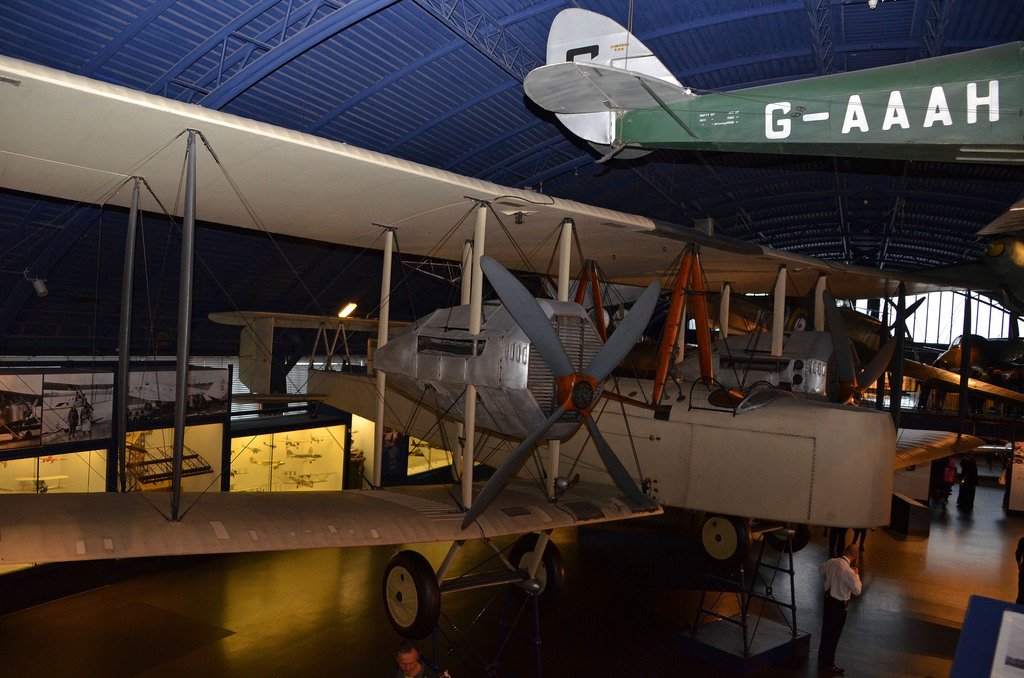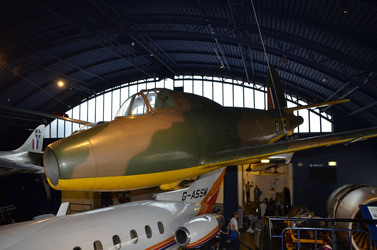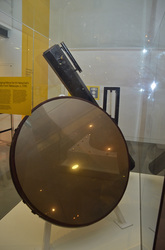Sign In
CloseThis is the aircraft in which John Alcock and Arthur Whitten Brown made the first non-stop crossing of the Atlantic in June 1919. The Vimy had been designed in 1917 as a bomber, but when the First World War ended this example was converted with extra fuel tanks to attempt the crossing. The pair left Newfoundland on 15 June and landed at Clifden in Connemara, Ireland some 16 hours later to become national heroes.
British aviators Alcock and Brown made the first non-stop transatlantic flight in June 1919.[1] They flew a modified World War I Vickers Vimy[2] bomber from St. John's, Newfoundland, to Clifden, Connemara, County Galway, Ireland.[3] The Secretary of State for Air, Winston Churchill, presented them with the Daily Mail prize for the first crossing of the Atlantic Ocean in 'less than 72 consecutive hours'.[4] There was also a small amount of mail carried on the flight making it the first transatlantic airmail flight. The two aviators were awarded the honour of Knight Commander of the Most Excellent Order of the British Empire (KBE) a week later by King George V at Windsor Castle.
John Alcock was born in 1892 in Seymour Grove, Old Trafford, Manchester, England. Known to his family and friends as "Jack", he first became interested in flying at the age of seventeen and gained his pilot's licence in November 1912. Alcock was a regular competitor in aircraft competitions at Hendon in 1913/14. He became a military pilot during World War I, and was taken prisoner in Turkey after the engines on his Handley Page bomber failed over the Gulf of Xeros.[5] After the war, Alcock wanted to continue his flying career and took up the challenge of attempting to be the first to fly directly across the Atlantic.
Arthur Whitten Brown was born in Glasgow in 1886 to American parents, and shortly afterwards the family moved to Manchester. Known to his family and friends as "Teddie", he began his career in engineering before the outbreak of World War I. Brown also became a prisoner of war, after being shot down over Germany. Once released and back in Britain, Brown continued to develop his aerial navigation skills.
In April 1913 the London newspaper The Daily Mail offered a prize of £10,000[6] to
“ "the aviator who shall first cross the Atlantic in an aeroplane in flight from any point in the United States of America, Canada or Newfoundland and any point in Great Britain or Ireland" in 72 continuous hours".[7] ”
The competition was suspended with the outbreak of war in 1914 but reopened after Armistice was declared in 1918.[7]
During his imprisonment Alcock had resolved to one day fly the Atlantic, and after the war he approached the Vickers engineering and aviation firm at Weybridge, who had considered entering their Vickers Vimy IV twin-engined bomber in the competition but had not yet found a pilot. Alcock's enthusiasm impressed the Vickers' team and he was appointed as their pilot. Work began on converting the Vimy for the long flight, replacing the bomb carriers with extra petrol tanks.[8] Shortly afterwards Brown, who was unemployed, approached Vickers seeking a post and his knowledge of long distance navigation convinced them to take him on as Alcock's navigator.
Several teams had entered the competition and when Alcock and Brown arrived in St. John's, Newfoundland, the Handley Page team were in the final stages of testing their aircraft for the flight but their leader, Admiral Mark Kerr, was determined not to take off until the plane was in perfect condition. The Vickers team quickly assembled their plane and at around 1:45 p.m. on 14 June, whilst the Handley Page team were conducting yet another test, the Vickers plane took off from Lester's Field.[10] Alcock and Brown flew the modified Vickers Vimy, powered by two Rolls-Royce Eagle 360 hp engines.[11] Their altitude varied between sea level and 12,000 ft (3,700 m) and upon take-off they carried 865 imperial gallons (3,900 L) of fuel. For part of the journey the airspeed indicator was out of action, probably because of being iced-up, and Whitten Brown had to make his own estimate of the speed for the purposes of dead reckoning. They made landfall in Galway at 8:40 a.m. on 15 June 1919, not far from their intended landing place, after less than sixteen hours' flying time. The aircraft was damaged upon arrival because of an attempt to land in what appeared from the air to be a suitable green field but which turned out to be a bog, near Clifden in County Galway, Ireland, but neither of the airmen was hurt.[10][12] They had spent around fourteen-and-a-half hours over the North Atlantic crossing the coast at 4:28 p.m.,[13] having flown 1890 miles (3040 km) in 15 hours 57 minutes at an average speed of 115 mph (185 km/h).[14] Their first interview was given to Tom 'Cork' Kenny of The Connacht Tribune.
Alcock and Brown were treated as heroes on the completion of their flight.[15] In addition to the Daily Mail award of £10,000, the crew received 2,000 guineas from the Ardath Tobacco Company and £1,000 from Lawrence R. Phillips for being the first British subjects to fly the Atlantic Ocean. Both men were knighted a few days later by King George V.[16]
Alcock and Brown flew to Manchester on 17 July 1919, where they were given a civic reception by the Lord Mayor and Corporation and awards to mark their achievement.
Submission Information
- Views:
- 1520
- Comments:
- 0
- Favorites:
- 0
- Rating:
- General
- Category:
- Visual / Photography




